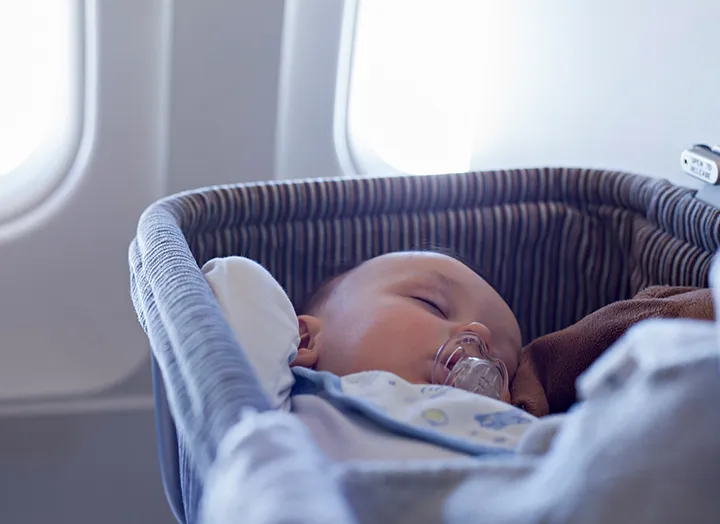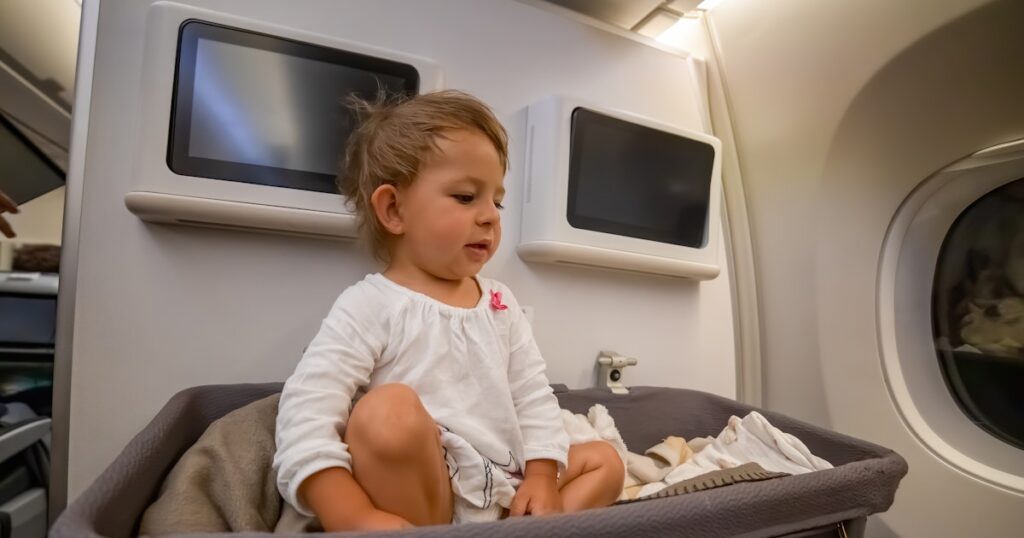Airplane Bassinet: A Guide for Traveling with Infants
Air travel with an infant can be a daunting task, especially for first-time parents. One of the biggest concerns for parents is how to keep their baby comfortable and safe during the flight. This is where airplane bassinets come in handy. Airplane bassinets are specially designed cots that attach to the bulkhead wall of the aircraft and provide a comfortable sleeping area for infants.
Understanding Airplane Bassinets
Airplane bassinets are typically reserved for infants who are under a certain weight and height limit, usually around 20-25 pounds and 26-32 inches respectively. They are available on most long-haul flights and some short-haul flights, but availability may vary depending on the airline and aircraft. It is important to note that airplane bassinets are not guaranteed, and parents should always call ahead to confirm availability and make a reservation if possible.
Airline Bassinet Policies and Procedures
Each airline has its own policies and procedures when it comes to airplane bassinets. Some airlines require parents to bring their own blankets and pillows, while others provide them. Some airlines also have restrictions on when the bassinet can be used, such as during takeoff and landing or when the seatbelt sign is on. It is important for parents to familiarize themselves with the policies and procedures of the airline they are flying with to ensure a smooth travel experience.
Key Takeaways
- Airplane bassinets are specially designed cots that attach to the bulkhead wall of the aircraft and provide a comfortable sleeping area for infants.
- Airline policies and procedures for airplane bassinets vary by airline and parents should always call ahead to confirm availability and make a reservation if possible.
- It is important for parents to familiarize themselves with the policies and procedures of the airline they are flying with to ensure a smooth travel experience.

Understanding Airplane Bassinets
Basics of Airplane Bassinets
An airplane bassinet is a small, fold-down bed that is attached to the bulkhead wall in the aircraft cabin. It is designed to provide a safe and comfortable sleeping space for infants during long flights. These bassinets are typically reserved for families traveling with infants and are available on a first-come, first-served basis.
Most airplane bassinets have weight limits that range from 20 to 30 pounds and are suitable for infants up to 6 months old. The size of the bassinet can vary depending on the airline and aircraft type, but they are generally around 30 inches long and 14 inches wide.
To ensure the safety of the infant, parents must follow the guidelines provided by the airline. This includes using the provided harness to secure the infant in the bassinet and not allowing the infant to be unattended in the bassinet.
Types of Bassinets on Aircraft
There are two main types of airplane bassinets: overhead and bulkhead. Overhead bassinets are attached to the overhead compartments and can be accessed by the parent during the flight. Bulkhead bassinets are attached to the bulkhead wall and cannot be accessed during the flight.
Overhead bassinets are generally larger and can accommodate infants up to 30 pounds, while bulkhead bassinets are smaller and can accommodate infants up to 20 pounds. Some airlines also offer convertible bassinets, which can be adjusted to fit infants of different sizes.
It is important to note that not all airlines offer bassinets on their flights, and those that do may have limited availability. It is recommended to check with the airline prior to booking to ensure that a bassinet will be available for use during the flight.

Airline Bassinet Policies and Procedures
When traveling with an infant, parents often wonder if they can reserve a bassinet seat on the airplane. Most airlines do offer this option, but it is important to understand their policies and procedures before making a reservation.
Booking and Reservation Policies
To reserve a bassinet seat, parents must usually contact the airline directly or make a request through their travel agent. It is important to note that bassinet seats are limited and subject to availability. Some airlines may charge an additional fee for this service, while others offer it free of charge.
It is recommended that parents book their bassinet seat as early as possible to ensure availability. Most airlines require that infants using a bassinet seat be under a certain weight and height limit, typically around 20 pounds and 26 inches.
Safety and Usage Guidelines
Airline bassinets are designed to provide a safe and comfortable sleeping space for infants during a flight. However, it is important to follow the airline’s safety and usage guidelines to ensure the safety of the child.
Parents should always secure their child in the bassinet using the provided harness and follow any instructions given by the flight attendants. It is also important to note that the bassinet may only be used during certain phases of the flight, such as cruising altitude, and must be stowed away during takeoff, landing, and turbulence.
Overall, parents should familiarize themselves with the airline’s policies and procedures regarding bassinet seats before making a reservation. By doing so, they can ensure a safe and comfortable flight for their infant.
Choosing the Best Bassinet Seat
When traveling with an infant, choosing the right bassinet seat can make all the difference in ensuring a comfortable and stress-free flight. Here are some factors to consider when selecting the best bassinet seat for your baby.
Bulkhead Seats and Their Advantages
Bulkhead seats are the most popular choice for parents traveling with infants. These seats are located at the front of the cabin and have a wall or partition in front of them, providing extra legroom and space for a bassinet to be attached. Bulkhead seats are usually reserved for passengers with infants and are often available for free or at a reduced cost.
One of the main advantages of bulkhead seats is that they offer more space and privacy for parents and their baby. The lack of a seat in front means that there is no one reclining into your space, and you can easily access your carry-on bags and other items during the flight. Additionally, the partition in front of the seat provides a barrier between your baby and the rest of the cabin, reducing noise and distractions.
Weight and Age Considerations
When selecting a bassinet seat, it’s important to consider the weight and age restrictions of the airline. Most airlines have a weight limit of around 20-25 pounds for bassinet use, and some may have age restrictions as well. It’s essential to check with the airline before booking your flight to ensure that your baby meets the requirements for using a bassinet.

It’s also important to note that not all bassinets are created equal. Some airlines provide larger and more comfortable bassinets than others, so it’s worth doing some research before booking your flight. Additionally, some airlines may only have a limited number of bassinets available, so it’s essential to book your seat early to avoid disappointment.
In conclusion, choosing the best bassinet seat for your baby can help make your flight more comfortable and enjoyable. Consider the advantages of bulkhead seats and the weight and age restrictions of the airline when making your decision. With a little research and preparation, you can ensure a stress-free flight for you and your baby.
Traveling with Infants on Airplanes
Preparing for the Flight
Traveling with an infant on an airplane can be a daunting task, but with proper preparation, it can be a smooth and stress-free experience. Parents should check with the airline about their policies on traveling with infants and make sure to book a bassinet in advance if needed. It is also important to pack all necessary items such as diapers, wipes, formula, and a change of clothes in a carry-on bag. Parents should also consider bringing a baby carrier or a stroller that can be gate-checked.
During the Flight
Once on board, parents can request a lap belt for their baby or use a FAA-approved car seat if they have purchased a seat for their infant. If a bassinet has been reserved, parents should inform the flight attendant and follow the instructions for setting it up. During takeoff, landing, and turbulence, parents should hold their baby securely in their lap or use the lap belt provided. It is also important to keep the baby calm and comfortable by feeding, changing, and providing opportunities for rest.
Overall, traveling with an infant on an airplane requires careful planning and attention to detail. By following the airline’s policies, packing essential items, and keeping the baby safe and comfortable during the flight, parents can have a successful and enjoyable trip.
Airline-Specific Bassinet Information
Major International Airlines
For international flights, several major airlines provide bassinets for infants. These airlines include American Airlines, Air France, Air New Zealand, ANA, Emirates, Etihad, and Qantas. It is important to note that each airline has different policies and guidelines regarding the use of bassinets, so it is recommended to contact the airline directly for specific information.
American Airlines provides bassinets on a first-come, first-served basis for infants weighing up to 20 pounds. Air France offers bassinets for infants weighing up to 22 pounds, but they must be reserved in advance. Air New Zealand provides bassinets for infants up to 8 months old and weighing up to 26 pounds. ANA offers bassinets for infants up to 18 months old and weighing up to 22 pounds. Emirates provides bassinets for infants up to 2 years old and weighing up to 22 pounds. Etihad provides bassinets for infants up to 2 years old and weighing up to 30 pounds. Qantas provides bassinets for infants up to 8 months old and weighing up to 22 pounds.
Regional and Budget Airlines
Regional and budget airlines may also provide bassinets for infants on international flights, but the availability and policies may vary. It is recommended to contact the airline directly for specific information.
In general, it is important to note that bassinets may not be available on all flights, and there may be restrictions on their use. For example, some airlines may not allow the use of bassinets during takeoff, landing, or turbulence. It is also important to ensure that the infant meets the airline’s age and weight requirements for using a bassinet.
Overall, parents traveling with infants should contact their airline in advance to inquire about the availability and policies regarding bassinets. With proper planning and communication, parents can ensure a comfortable and safe flight for their little one.
Additional Considerations and Tips
Cost and Fare Implications
Airplane bassinets are typically provided free of charge by airlines for passengers traveling with infants. However, it is important to note that not all airlines offer this service, and those that do may have limited availability. It is recommended that passengers check with their airline in advance to confirm availability and any associated costs.
In addition to the bassinet, passengers may also need to purchase an infant ticket for their child. This can vary in cost depending on the airline and the destination. Passengers should also be aware that some airlines may require that infants have their own seat, which can significantly increase the cost of travel.

Packing and Accessories
When traveling with an infant, it is important to pack efficiently and bring only the essentials. Passengers should consider bringing a small bag or backpack to store items such as diapers, wipes, and extra clothing. It is also recommended to bring a few blankets, as airplane cabins can become chilly.
One accessory that can be particularly useful when using an airplane bassinet is the Cozigo sleep and sun cover. This cover fits over the bassinet and helps to create a dark and cozy environment for the infant to sleep in. It also provides protection from the sun and other distractions.
Passengers should also be aware that there may be restrictions on the types of items that can be brought on board the plane. It is important to check with the airline in advance to determine what items are allowed and any size or weight restrictions.
Overall, traveling with an infant can be challenging, but with proper planning and preparation, it can also be a rewarding experience. Passengers should prioritize their child’s comfort and safety, and be prepared to adapt to any unforeseen circumstances that may arise.
Alternatives to Airplane Bassinets
Travelling with an infant can be a daunting task, especially when it comes to ensuring their comfort and safety on a long flight. While airplane bassinets are a popular choice for parents, they may not always be available or suitable for every situation. In this section, we will explore some alternatives to airplane bassinets.
Using Car Seats on Planes
One option for parents is to use a car seat on the plane. This can provide a familiar and comfortable environment for the infant, as well as ensuring their safety during the flight. However, it’s important to note that not all car seats are approved for use on airplanes, so parents should check with the airline beforehand. Additionally, car seats can be bulky and heavy, which may not be practical for some parents.
Portable Travel Solutions for Infants
For parents who prefer a more portable solution, there are a variety of travel cots and portable bassinets available on the market. These can be lightweight and easy to pack, making them a convenient option for parents on the go. However, it’s important to ensure that the cot or bassinet is suitable for use on airplanes and meets all safety regulations. Additionally, some airlines may have a limited number of bassinets available, so parents should check with the airline beforehand and make arrangements if necessary.
Overall, there are a variety of alternatives to airplane bassinets that parents can consider when travelling with an infant. By doing some research and planning ahead, parents can ensure that their child’s journey is as comfortable and safe as possible.
Frequently Asked Questions
What is the weight limit for using an airplane bassinet?
Most airlines have a weight limit of around 20 pounds for using an airplane bassinet. However, this can vary depending on the airline and the specific model of the bassinet. It is best to check with the airline before booking your flight to ensure that your baby is within the weight limit.
Up to what age can my baby use the in-flight bassinet?
The recommended age limit for using an in-flight bassinet is around 6 months old. However, this can also vary depending on the airline and the specific model of the bassinet. Some airlines may allow babies up to 1 year old to use the bassinet. It is best to check with the airline before booking your flight to ensure that your baby is within the recommended age limit.
How do I secure a bassinet seat when flying with United Airlines?
To secure a bassinet seat when flying with United Airlines, you will need to call the airline’s customer service and request a bassinet seat. These seats are limited and available on a first-come, first-served basis. It is recommended to request a bassinet seat as early as possible to ensure availability.
What are the dimensions of Delta’s in-flight bassinets?
Delta’s in-flight bassinets have dimensions of approximately 29 inches x 13 inches x 7 inches. These dimensions may vary slightly depending on the specific model of the bassinet. It is best to check with the airline before booking your flight to ensure that your baby’s dimensions are within the recommended size limit.
Which airlines offer the best bassinets for infants during travel?
The quality and availability of bassinets can vary greatly among different airlines. Some airlines that are known for offering high-quality bassinets for infants during travel include Emirates, Singapore Airlines, and Qatar Airways. However, it is recommended to check with the airline before booking your flight to ensure that they offer bassinets and that they meet your specific needs.
Are passengers allowed to bring their own foldable bassinets on a plane?
Most airlines do not allow passengers to bring their own foldable bassinets on a plane. This is because the airline’s own bassinets are designed to meet specific safety standards and regulations. It is best to check with the airline before booking your flight to ensure that you are aware of their specific policies regarding bringing your own bassinet on board.








